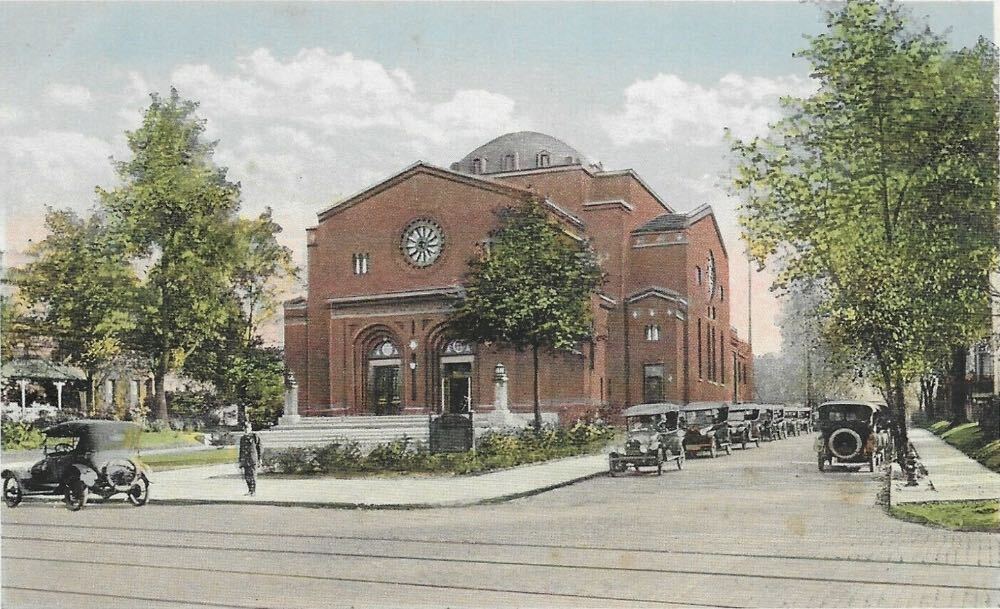
In 1841, a rift opened within a German Orthodox congregation of a Bavarian Unsleben party that met in a rented room on Prospect Street. Known as the Israelite Congregation, it was formed just two years earlier as Cleveland’s first Jewish congregation. The group split over religious differences, with the departing members forming Anshe Chesed, meaning “the People of Loving-kindness.” The factions reunited in 1845 under the name Israelitic Anshe Chesed Society of Cleveland and soon built a synagogue on Eagle Street. This building was relatively small at 35 by 50 by 28 feet. After some disagreements over religious rituals in 1850, some members left to follow Rabbi Isidor Kalisch and establish Tifereth Israel. The Anshe Chesed then hired Rabbi Bernard L. Fould from Bavaria who headed the congregation from 1850 to 1875.
From 1861 to 1865, Rabbi Fould and chazan Gustava M. Cohen instituted many reforms, introduced an organ, tore down the women’s gallery, and installed pews. They also turned the reader of scripture from the Ark’s direction toward the audience. There were significantly more changes, later helped by Rabbi Michaelis Machol during his leadership from 1876 to 1906, converting Anshe Chesed from traditional to reformed Judaism. After the changes that Rabbi Michaelis Machol made during his leading congregation, they adopted English sermons, more moderate prayer books and services that switched between the Hebrew and English language. Some of these changes would later be reversed by Rabbi Barnett Brickner in the 1920s. Meanwhile, in 1887 the congregation relocated to a bigger building on Scovill Avenue and Henry Street (now East 25th). The 125-foot temple had alternating layers of white and red sandstone with octagonal turrets and three arching entrances. Designed by Lehman and Schmitt, the building could comfortably seat 1,200 people.
Rabbi Louis Wolsey from Little Rock, Arkansas, succeeded Rabbi Machol in 1907. The Anshe Chesed Congregation then announced their move to a location previously owned by Cassie Chadwick, who was known for defrauding banks out of millions by saying that she was an heir of Andrew Carnegie. Located on Euclid Avenue and East 82nd Street, Chadwick’s mansion was in the process of demolition in January of 1910, three years after she died in prison. On the vacant land, the Anshe Chesed planned to erect a synagogue designed by Lehman and Schmitt, the same architects who designed their previous home, and set aside $200,000 for construction. Rabbi Wolsey was said to favor an oriental style of architecture with tall columns and porticos for the new building. They cut some of the costs by choosing red brick instead of Indiana limestone, allowing them to spend the saved $50,000 on different amenities that included a new organ and pews.
In 1912, the congregation dedicated its new Euclid Avenue Temple. To commemorate the opening, they lit the eternal fire before the marble Ark representing God’s eternal presence. Within the Ark, there is a scroll of the Jewish law made of satin and gold. A sermon preached by Rabbi Wolsey gave thanks to God, who they believed allowed the building to be erected by His will and for His worship . The temple could seat 1,500 attendants and had one of Cleveland's largest organs at the time with 4,000 pipes. The temple had eight stained glass windows made by Tiffany and Company that each depicted moments of Jewish history as told in the Torah. The woodwork and pews had a silver-gray finish while the carpets and seating upholstery were a deep red. The Ark was made of French marble with two candelabras standing on each side made of bronze. Behind the choir lofts, a glass mosaic was imprinted with a verse from the book of Psalms, completing the synagogue. With all these extra expenses, the cost rose to $250,000.
Beginning in 1925, the Euclid Avenue Temple entered a new three-decade era in which it would become inseparable from the imprint of a new Rabbi. Born in New York City to Russian Jewish immigrants, Rabbi Barnett Brickner was a staunch Zionist and brought a new vision to Anshe Chesed. Rabbi Brickner moved away from many of the classical Reform practices of Anshe Chesed's prior years and reinstated many older Jewish traditions in services. So thoroughly did he shape Anshe Chesed that the synagogue became commonly known as "Brickner's Temple."
In 1956, Anshe Chesed, numbering 2,300 families, sold the building to a local African American congregation, Liberty Hill Baptist Church, which became the second Black church on Euclid Avenue, Anshe Chesed moved to their current location on Fairmount Boulevard in the eastern suburb of Beachwood. There they are known as the Anshe Chesed Fairmount Temple. At this new location, the congregation pushed for more civil and political rights for all Americans, even helping Soviet Jews relocate to America to flee persecution. The congregation also welcomed lesbian, gay, bisexual, and transgender Jews and their families, and they tasked Chevrei Tikva Chavurah in 2005 with undertaking outreach to the LGBT community. As a result of these actions, the Anshe Chesed Fairmount Temple received the Equality Award from the Human Rights Campaign Cleveland.
Anshe Chesed has a long history tied to the roots of Cleveland, but like most Jewish organizations, the congregation left the City of Cleveland as its members moved farther eastward into the suburbs. It cannot be understated that this group has had a lasting impact on Jewish culture in Cleveland, including leaving a wonderful architectural legacy that continues to serve members of Liberty Hill Baptist Church. In the past and to this day, the Anshe Chesed congregation is an advocate of social reform and outreach.
Images








